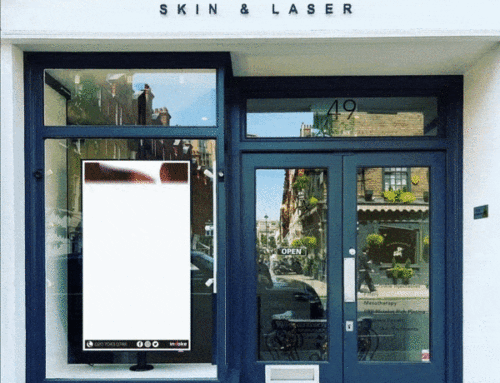When “Diamonds Are Forever” came out in 1971, film buffs and James Bond fanatics got a sneak peek at a futuristic technology that is now so mainstream that many of us carry it around in our pockets as part of our smartphones: A biometric fingerprint scanner.
Historically, biometric technologies such as retina, facial and fingerprint scans were used primarily for security systems and access. These technologies scan physiological characteristics of humans such as eyes, faces and fingerprints to gather data on a person’s identity — which can be used to verify if he or she is allowed entry to a specific area, for example.
Today, these same solutions are being used to supply statistical information that can be analyzed to identify data about a person’s behavior and engagement. This kind of technology has been around for years, and only very recently has been deployed to help digital signage deliver truly meaningful and impactful content.
The capabilities of biometrics and analytics are realized when combined with other technologies — such as digital signage — to hone marketing techniques with smarter content. Exact slices of a desired demographic can be targeted by using tools such as anonymous facial analysis to gather information about a customer and his or her level of interaction and engagement with a product. This information then triggers predetermined content based on the knowledge supplied to the system.
Biometrics coupled with digital signage has the ability to:
- measure passing traffic, viewing audience, age, gender, dwell times, effectiveness of screen placement and even mood;
- serve content based on custom criteria and real-time demographics;
- measure content effectiveness remotely in real time;
- monitor analytics from any location and view displayed content;
- adjust content from any location to achieve better reach; and
- present on-screen options for check-in, loyalty programs, surveys, dynamic pricing and product information.
For digital out-of-home advertising, these capabilities allow a brand to truly understand and target its most engaged audience by delivering information specific to their needs and interests — the key to successful marketing. Customers enjoy better engagement with the brand and shopping experiences, while retailers increase targeted marketing and sales profitability.
There are a number of industries in which biometrics can be paired with digital signage for smarter DOOH advertising, including — but not limited to — retail, entertainment and transportation.
Retail
Biometrics and interactive digital technology can deliver targeted content in real time during the shopping experience, engaging customers while upping sales and creating stronger brands for retailers.
For example, facial-detection tools help supply data that retailers can use to best understand their audience and create stronger target marketing to their customers. This marketing can be pre-supplied using planned strategies based on “known” shoppers, or can be contextual signage triggered by age and gender. For example, if a customer in a particular age range is captured by the analytics engine, content can appear on a digital display, marketing products geared for their age group and gender.
This technology can further be coupled with tools like RFID to create an even more interactive experience for the shopper. For example, if a shopper was to select a marketed clothing item, further information will display on the digital sign showing how that product looks on a person of the same age range and build, as well as suggest pants or a jacket that would look good with it and where the customer could find those items in the store. All of this increases the overall experience for the customer.
On the back end, these data supply the retailer with information on trends, customers and engagement, which allows for stronger understanding and analysis of future marketing decisions.
A point-of-sale system also can be integrated with the analytics and biometrics component. A store could see how many advertised items ended up on the same receipt, the demographic of the purchaser and whether items were purchased during times they were advertised on digital displays, showing the true impact of an ad campaign on a screen.
Entertainment
Theme parks can improve guest experience as well as drive sales and engagement by implementing tactics such as biometric facial detection to track visitors’ movements around the park. If a customer is a VIP or frequent guest and has opted into the brand’s loyalty program, a camera can capture his or her face and allow access to areas such as VIP entrances, fast-pass lines or other special events without the member needing to check in with staff.
At souvenir shops in theme parks, facial analysis is able to trigger content targeted toward customers’ age and gender. This gives the ability to create a more personalized and impactful branding campaign. For example, a child would be interested in ads for toys and games, whereas an adult would be more interested in seeing ads for a shirt or hat.
In places like museums or zoos, biometric facial detection can trigger informational content on displays based on demographics. Vocabulary and images can be better suited to age range — more pictures and short “did you know” facts for children, a deeper dive into the subject for adults — creating a customized user experience that keeps people coming back.
Transportation
A transportation hub like an airport has multiple possibilities for using biometrics. At frequent-flyer lounges, VIPs can simply walk past a camera that uses facial recognition to verify the person is a member, and in they go — no waiting in line to show an ID.
While patrons are inside the lounge, biometrics combined with analytics and digital signage can target content toward specific demographics to play on nearby displays. For example, knowing that Monday mornings tend to serve business travelers, the airport is able to supply content that is specifically targeted toward the business community. If during that time, however, there instead is a huge influx of younger audience members — a school field trip, for example — the content can flip and showcase content that will interest the audience.
Uses expand beyond the VIP section. DOOH networks that run ads in airports are able to better target ads based on customer groups. An adult tour group sitting at a gate would be interested in a different kind of advertisement than a high school group sitting in a food court, and networks can use biometrics to run ads in real time that are more meaningful to a demographic instead of using the same ad over and over again.
Signage of the future
Digital signage these days is about more than just showing an image on a screen. Running a DOOH ad without the enhanced knowledge that biometrics and analytics bring is simply throwing something at a wall to see what sticks. Brands are now able to take what is important to an individual or group and put it in front of them in a way that is more relevant to the viewer, using intelligent digital signage.
Biometrics and analytics should be considered as another component of a brand’s omnichannel strategy, combining multiple technologies and forms of marketing to appropriately target demographics and engage audiences.
Diamonds are forever, and so is the need to keep up with the ever-changing needs of customers.
Original post by: Digital Signage Today
Richard Ventura is vice president of business development and solutions for NEC Display Solutions. He can be reached at rventura@necdisplay.com.



